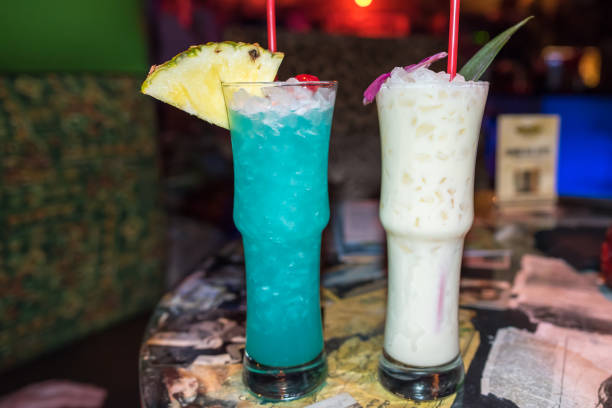Innovating and mixing drinks is an art. The 21st-century cocktail renaissance, where craft cocktail bars are everywhere, and classic cocktails have returned to fashion, has proven this. What about naming the drinks?
Some bartenders find that naming their new concoctions the most difficult part of the process. Cocktail names are important because they have to work hard on the menu of a bar. A title should first pique the interest of a potential customer. It should also convey a message about the drink, perhaps referring to its origin or highlighting an important ingredient.
A cocktail’s name gives its creator a chance to express their intentions. The name of a cocktail is an opportunity for the creator to express their creativity. The name of a drink can enhance the aesthetics of the entire establishment.
It wasn’t always so complicated…
The term Cocktail now refers to a wide range of mixed alcoholic drinks, ranging from the sophisticated Martinis to the fruity and umbrella-adorned Mai Tais. When the Cocktail first appeared in America around the turn of the 19th Century, its meaning was more limited. A cocktail, according to the earliest known written definition, was a mixture of “spirits, sugar, water and bitters” in that period.
Cocktails were a type of mixed drink, distinct from other styles such as punches and flips. They also differed in the ingredients they used. Early cocktail names were usually just a reference to the spirit used. Whiskey-Cocktail; Gin-Cocktail.
What about the word Cocktail? Cocktail expert David Wondrich thinks he has cracked the case. “If you have an old horse that you are trying to sell, put some ginger in its butt, and it will cock its head up and be frisky. This was called a ‘cock-tail.
The Cocktail was born as a result of the Industrial Age. The communal punch bowls, which had been used for leisurely drinking at taverns, were replaced by single-serving drinks, such as the Cocktail, that could be ordered and consumed individually. As the Cocktail became more popular, American bartenders started to experiment with its formula. They created “fancy” and improved versions of the drink that included liqueur or absinthe. Vermouth was imported from Europe in the late 19th Century and began to be used in cocktails.
To differentiate the original recipe and its many variations, a retronym has been adopted. It was once a Cocktail and is now referred to as an Old-Fashioned Cocktail or a Traditional.
How were the new cocktails named then? In order to incorporate other types of mixed drinks into the Cocktail, some names were created by simply combining the spirit and the style. Examples include the gin fizz or the whiskey sour. Nevertheless, new variations of those styles led to the creation of names that were less literal and more creative. Over time, bartenders have developed a few naming conventions that guide them today.
Keep it local
The name of several classic cocktails is derived from the bar where they were first created. In the early 20th Century, for example, the La Louisiane was built in New Orleans, the Pegu Club in Yangon/Rangoon, and the Hotel Nacional special in Havana, each named after the place where the drink is served as a specialty. This convention has become less popular, but it is still present. The Lost Lake is the signature cocktail of Chicago Tiki.
Some cocktail names are derived from the place or city where the drink originated. The Manhattan is the most famous Cocktail. It was a vermouth-based cocktail that became popular in the late 19th Century. Its exact origins are not known, but it is almost certain to have originated in this New York City borough. Another example is the Singapore Sling, credited to Singapore’s legendary Raffles Hotel in the early twentieth Century.
Tribute acts
Unfortunately, history has forgotten many of those who created classic cocktails. Their drink names immortalize those who have made classic cocktails. Henry C. Ramos of New Orleans is one early example. He is remembered for his Ramos Fizz. A London waiter named John Collins’ 19th-century gin cocktail is best known as the Tom Collins. This is due to a variety of reasons. The Negroni, on the other hand, was named after a count from Italy who preferred his Americano Aperitif to be made with gin rather than soda water.
Celebrities often inspired early 20th-century cocktail names. This was a trend that continued into the 21st Century. Mixology was used to pay tribute to stars from the era, such as Mary Pickford and Charlie Chaplin.
Cocktails named after celebrities of today are uncommon. Bartenders sometimes choose names from the past. Drinks that are a tribute to popular culture, such as songs, movies, and other entertainment, are more common. Paper Plane is a modern classic that was inspired by a 21st-century hip-hop hit, M.I.A.’s “Paper Planes.”
Key ingredients
Even though some of these names are fun, they don’t really convey what is actually in the beverage. A bartender can do this by referencing the ingredients directly. (e.g., the Ginger Basil Smash). Many prefer, however, to go roundabout.
The Jersey Cocktail is an early example of a drink with a name other than the base spirit. It was named after the hard apple cider that was produced in New Jersey. The Moscow Mule is also based on vodka, as is the Oaxaca-Old-Fashioned, which mixes Tequila with Mezcal.
Cocktail names have often been based on puns. Because the Italian liqueur Cynar contains artichokes and is laced with alcohol, Cynar-laced cocktails have names like The Art of Choke Choke Holder and Choke Artist.
Common sense
The appearance of the drink may give away its name. The 19th century Coffee Cocktail does not contain any coffee. Instead, it is a mixture of Cognac and Port. Its appearance, however, is similar to that of a cup of coffee. The Tequila Sunrise has layers of red and orange in the glass. At the same time, the Dark’ n’ Stormy has a heady brew made of dark rum and fizzy Ginger Beer.
Some cocktail names are directly related to their taste. A drink with a smoky taste, such as Scotch or mezcal, might be named Smokeshow. When it comes to flavors that all drinkers do not appreciate, it is a good idea to include words like smoky, spicy, or bitter.
Results desired
There is also a tradition that cocktail names are named after the effect they purport to have. Take the Corpse Reviver Number. The best-known of a series of cocktail variations from the Prohibition era is No. 2. The name corpse reviver is similar to the Cocktail, which was intended to be a drink to boost the spirits of the person drinking it. The Savoy Cocktail Book, published in 1930, includes a warning: “Four drinks taken quickly will revive the corpse.” Another tiki cocktail known as Painkiller makes its intentions clear. This Cocktail uses strong rum in line with the tiki culture goal of providing an escape from everyday life.
What about the provocative drinks from the 1980s, like the Sex on the Beach or the Sloe Comfortable screw? Michael Neff, a writer and bartender, speculates that these names “reflected what people were looking for from a bar in the 1980s”. The drinks helped facilitate their fun.
Killer riffs
The cocktail revival has seen a rise in interest and awareness of cocktail history over the last two decades. Bartenders, as well as other cocktail enthusiasts, have tracked the evolution and origins of different drinks to give credit where it is due. When creating new glasses, they often draw inspiration from the past, using an older cocktail as a starting point or template. The name of the new Cocktail, which is a riff on an old one, allows you to acknowledge the heritage. It is easiest to keep a part of the name from the original. A Manhattan that uses a bitter, dark amaro in place of a sweet vermouth would be called a Black Manhattan.
One approach is to assume that the original Cocktail and the new creation belong to the same family of cocktails. This convention is best known for a series of riffs created on the Brooklyn cocktail, which consists of rye whisky, dry vermouth, and two liqueurs. The Brooklyn, in turn, is a riff of the Manhattan. The variations keep the rye but change the vermouths and liqueurs to create a unique cocktail in the same style. All of them were named in honor of their Brooklyn roots: Red Hook. Bensonhurst. Greenpoint. Cobble Hill. Bushwick.
Opting out
Kindred Cocktails is an online database that contains more than 6,000 cocktail recipes. Some of the drinks have the same name but are completely different. Their online presence discourages bartenders from repurposing them. It’s not surprising that bartenders avoid the naming procedure because so many names are already taken.
Naren Young is the bar director of Dante, a New York-based restaurant. He said: “Bars are confusing enough without giving people a list of drinks that have nonsensical titles ….” To make his customers more confident and comfortable when ordering, Young fills his cocktail menus primarily with familiar drinks and styles. Some bartenders do not use names at all, as they feel that the characters are a distraction. Numbers may be substituted.
For the moment, however, establishments that don’t give their cocktails a name are in the minority. When bartenders create new drinks or beverage directors design menus, the importance of a good reputation is a major consideration.
Many bar professionals still follow William S. Adkins’s wisdom from The Practical Soda Fountain Guide, published in 1911: “A bad name won’t make a drink successful, but a name that is attached to a great drink makes a powerful combination.”
John M. Cunningham is a writer based in Chicago. For more than a decade, he worked at Encyclopaedia Britannica, where he served as its first Readers’ Editor and wrote articles on topics such as Justin Bieber and the National Spelling Bee. He is also a published crossword puzzle constructor and a cocktail lover.


